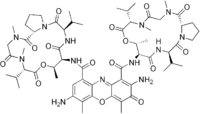7-Aminoactinomycin D
 | |
| Names | |
|---|---|
| Other names
7-Amino-actinomycin D | |
| Identifiers | |
| 7240-37-1 | |
| ChEBI | CHEBI:52304 |
| ChemSpider | 21326185 |
| |
| Jmol-3D images | Image |
| PubChem | 16218991 |
| |
| Properties | |
| C62H87N13O16 | |
| Molar mass | 1270.43 g/mol |
| Appearance | Red to dark purple powder |
| Hazards | |
| R-phrases | R26/27/28 R36/37/38 |
| S-phrases | S26 S28 S36/37 S45 |
| Except where noted otherwise, data is given for materials in their standard state (at 25 °C (77 °F), 100 kPa) | |
| | |
| Infobox references | |
7-Aminoactinomycin D (7-AAD) is a fluorescent chemical compound with a strong affinity for DNA. It is used as a fluorescent marker for DNA in fluorescence microscopy and flow cytometry. It intercalates in double-stranded DNA, with a high affinity for GC-rich regions,[2] making it useful for chromosome banding studies.[3]
Applications
With an absorption maximum at 546 nm, 7-AAD is efficiently excited using a 543 nm helium–neon laser; it can also be excited with somewhat lower efficiency using a 488 nm or 514 nm argon laser lines. Its emission has a very large Stokes shift with a maximum in the deep red: 647 nm. 7-AAD is therefore compatible with most blue and green fluorophores – and even many red fluorophores – in multicolour applications.
7-AAD does not readily pass through intact cell membranes; if it is to be used as a stain for imaging DNA fluorescence, the cell membrane must be permeabilized or disrupted. This method can be used in combination with formaldehyde fixation of samples.
7-AAD is also used as a cell viability stain. Cells with compromised membranes will stain with 7-AAD, while live cells with intact cell membranes will remain dark.
Actinomycin D
The related compound actinomycin D is nonfluorescent, but binds DNA in the same way as 7-AAD. Its absorbance changes when bound to DNA, and it can be used as a stain in conventional transmission microscopy.
References
- ↑ 7-Aminoactinomycin D at Interchim
- ↑ Liu X, Chen H, Patel D (1991). "Solution structure of actinomycin-DNA complexes: drug intercalation at isolated G-C sites". J Biomol NMR 1 (4): 323–47. doi:10.1007/BF02192858. PMID 1841703.
- ↑ Latt S (1977). "Fluorescent probes of chromosome structure and replication". Can J Genet Cytol 19 (4): 603–23. PMID 76502.
Gallery
-

Absorptions